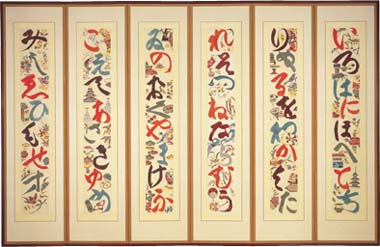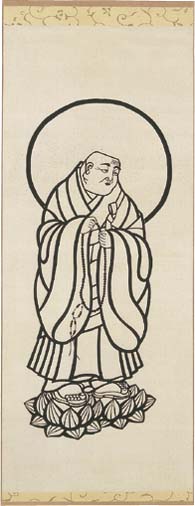![Obi [Sash]length
Pottery-making scenes in Tsuboya, Naha Okinawa](image/obi.jpg)
Obi [Sash] length
Pottery-making scenes in Tsuboya, Naha Okinawa, 1954 |

Serizawa’s innovativeness laid in his ability to do the entire dyeing process of underdrawing, stencil carving, and dyeing, in which there was usually a division of labor, himself. Serizawa, as a talented painter, commanded an exquisite sense of color and form and created numerous new designs, capturing people’s hearts.
|
![Noren [Entrance curtain]
Chinese character Kaze [Wind]](image/nolen.jpg)
Noren [Entrance curtain]
Chinese character Kaze [Wind], 1957 |

|

Serizawa transformed letters into beautiful designs. At eighty-one, he was invited to exhibit at the Grand Palais in Paris. His work,
Wind, was chosen as the exposition poster.
|
| Six-leaf Screen Japanese syllable, 1958 |
 |
 |
 |

Serizawa was not only commissioned to work on textiles but to create designs for various purposes, such as matchboxes, hanging lamps, stained glass, and interior decoration. Do you recognize Serizawa’s design for this Japan Airlines’ logo? |
 |
JAL Pamphlet Package
(detail) |

Serizawa studied nature through his sketches as well as early and modern works of art and applied art from East and West. When he was commissioned to produce religious art such as an illustrated biography of the Buddhist master Hônen and images of Christ and of the Buddha’s Ten Great Disciples, or even small pieces for a newspaper series, he researched on the iconographic and cultural background of his subjects.
|

Hanging scroll Portrait of Honen Shonin
(a Buddhist saint), 1942 |

Serizawa collected a variety of objects from valuable artwork to children’s toys, numbering approximately 5,500 works, across five continents. In this diverse collection, his refined eye is a consistent theme. Surrounded by these objects from around the world, Serizawa enjoyed rearranging his rooms for people to visit and gained inspiration
for his own works.
| Public Lectures |
The Life and Works of My Father
Chôsuke Serizawa

Professor Emeritus, Tôhoku University and Tôhoku Fukushi University
Director, Serizawa Keisuke Art and Craft Museum Tôhoku Fukushi University

2:00 p.m. on Sunday, July 17, 2005
MIHO MUSEUM South Wing Lecture Hall
The Works of the Designer Serizawa Keisuke
Seiichirô Shiratori

Assistant Curator, Shizuoka City Serizawa Keisuke Art Museum

2:00 p.m. on Sunday, August 14, 2005
MIHO MUSEUM South Wing Lecture Hall
|
|
![Obi [Sash]length
Pottery-making scenes in Tsuboya, Naha Okinawa](image/obi.jpg)

![Noren [Entrance curtain]
Chinese character Kaze [Wind]](image/nolen.jpg)



